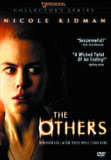| ..
|
rented
any good movies lately?
jump
to the
boards
and recommend it.
|
copyright ©1999-2002
DigsMagazine.com.
|

buy
the
DVD
| VHS
|
flick pick
|
The Others 2001
Directed + written by:
Alejandro Amenabar
Starring: Nicole Kidman, Fionnula Flanagan, Alakina Mann, James
Bentley
Language: English
Look for it at the video store under:
drama, thriller
Watch it when you’re in the mood
for
something: mind-bending,
scary
The critic says:
    /
5 the rating system
explained /
5 the rating system
explained
Fun factor:     /5 /5 |
Plot synopsis
In a big, looming mansion on a
fog-filled isle just off the British coast, Grace Stewart lives with her
two young children, Anne and Nicholas. Grace’s husband has been off
fighting in the war, leaving Grace all alone to look after the children,
both of whom suffer from a rare disorder that makes them extremely
hyper-sensitive to light. Because any exposure to bright light, whether
artificial of natural, makes them terribly, terribly ill, the children
must live in a state of near-pitch darkness; to ensure that no light
accidentally falls on either one, Grace has a strict set of rules that
she insists that everyone who lives in the house must follow at all
times. Curtains must be drawn tightly closed whenever the children are in a
room, doors must remain firmly shut when not in use, and no room must
ever have two doors open at the same time. When strange things start
happening, all signs point to the presence of ghosts, and the toll of
living with a possibly sinister supernatural presence makes life even
more difficult for emotionally fragile Grace, and the children as well.
When the entire house-staff takes off in the middle of one strange
night, Grace puts in an ad for new servants. Soon after, three mysterious strangers— Bertha Mills, Edmund Tuttle, and a mute
girl named Lydia— show up at the Stewart’s doorsteps, ostensibly to
take on the housekeeping duties.
Review
Alejandro Amenabar’s movies never sound
very enticing to me when I check out their little summaries on the back
of the video/DVD covers. The plots always read like standard
Hollywood-style horror/suspense stories, the sort that are meant to be
creepy/scary/mind-bending – except that by now, we’ve all seen the
same plot recycled so many times that these sorts of movies rarely offer
anything new. But young Spanish director Amenabar has a knack for
putting an interesting twist on the usual conventions, and making tired
genres feel fresh and unexpected for jaded viewers convinced they’re
too smart to be fooled by surprise endings. The Others is
Amenabar’s third feature film, and as with his first two films, you go
into the movie expecting one thing – in this case, your basic haunted
house horror story – and end up finding something quite different and
altogether more poignant (I’d tell you more, but the surprise element
is a big part of why the movie’s so enjoyable to watch). Amenabar sets
up his haunted house story perfectly – the spooky soundtrack, the
fog-filled landscape, the somber color palette, the elegant
cinematography, and the many shadowy nooks and crannies of the mansion
sliced by slivers of sunlight, all serve to create a beautifully
chilling, creepy atmosphere. There’s a slow, slow build-up to anything
remotely jump-out-of-your-seat scary, but it’s exactly that patient,
drawn-out ambience-building that lets the movie get under your skin: the
anticipation of something terrible, Amenabar understands, can be far
more frightening than seeing the horror itself ... it’s your imagination
that fuels your fright. Too often, people think that a fun movie is a
dumb movie, but The Others is a cool flick precisely because it
forces your mind to work, in a way that makes for truly superb entertainment.
—reviewed by
Y. Sun
--------------------------->
lounge . nourish
. host .
laze
. home .
|

